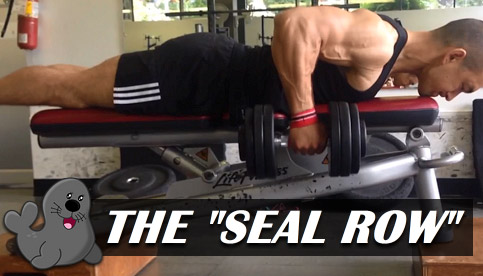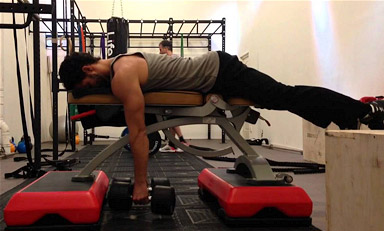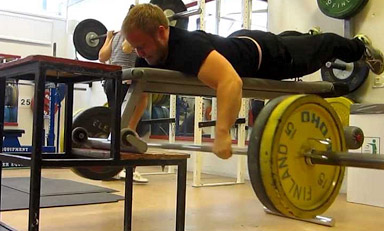THE “SEAL ROW”: A UNIQUE EXERCISE FOR A BIGGER BACK

When it comes to free weight rowing exercise for the back, standard bent over barbell rows and dumbbell rows are the typical “go to” movements for most lifters.
These basic foundational lifts are certainly a great way to stimulate the muscles of the back. But in this post, I want to introduce you to another rowing variation that you can try adding into the mix as well.
That variation is the “seal row,” which is similar to the incline chest supported row that I covered a few months back, except that you’ll be laying across a flat bench parallel to the floor with your legs straight behind you.
The seal row gets its name from the fact that, when you try to lift heavier weights on this exercise, your legs will often “flap” up and down behind you like a seal.
Although it’s a back exercise that you’ll almost never see being performed in most gyms, it does carry with it a few important benefits…
3 Benefits Of Seal Rows

First off, seal rows take your lower back almost completely out of the equation.
This allows you to place all of your focus on achieving maximum activation of the lats and mid-back muscles, and it’s also a great way to reduce lower back fatigue and “burn out” if you’re performing big compound lifts frequently throughout the week, such as squats and deadlifts.
If you experience lower back pain or discomfort during regular bent over free weight rows where the chest is not supported, then this is obviously another area where the seal row will benefit you.
Secondly, the seal row prevents the use of excessive momentum and cheating.
Since your entire body will be pinned against the bench, you won’t be able to “heave” the weight up like you can on other free weight rowing movements.
Not only does this reduce your chances of injury, but it also helps you increase the tension on the targeted muscles rather than shifting it onto your lower back and legs.
Third, having your chin pressed against the bench ensures that you maintain a neutral neck position throughout the exercise.
This is the way that all rowing exercises should ideally be performed in order to take pressure off of the spine, but it can easily be forgotten when performing a regular bent over barbell or dumbbell row.
Proper Seal Row Form
The first step to performing the seal row is getting your initial setup in place.
This can sometimes be a bit of a challenge depending on your gym and what’s available to you, and there are two main ways to go about it.
The first option is to take a decline bench and then elevate the bottom of the bench on top of a box or some other platform…
The second option is to use a flat bench and elevate both ends…

However you choose to go about it, your basic goal is to get the bench parallel to the floor (a slight incline or decline is no big deal), and to have it high enough off the ground so that you can fully extend the weights below you.
The seal row can be performed using a barbell or dumbbells as you see above. Although either version will be effective, I personally prefer the dumbbell seal row since it allows you to work iso-laterally to prevent strength imbalances, and also helps you retract your scapula more effectively for a better contraction in the lats.
However, either variation is acceptable and you can try both to see which one you prefer.
If you want to shift the emphasis onto the lats: Perform your seal rows using a narrow grip (palms facing in if using dumbbells) and pull the weight toward your waist/mid-section.
If you want to shift the emphasis onto the upper back and rear delts: Use a wider overhand grip and pull the weight higher up, more toward your chest.
The seal row may look easy, but you’ll probably end up having to use a much lighter weight than you think when first getting started. It’s a bit of a humbling exercise, and you don’t want to go overboard on weight if this is a new lift for you.
Start out modestly and really focus on squeezing and contracting the muscles of your back as effectively as you can, and then gradually increase the weight once you have the proper form nailed down.
Always think about driving the weight back using your elbows rather than just yanking it up with your hands, and make sure to retract your shoulder blades as you row the weight.
Give the seal row a try and see what you think. You can accomplish the same basic movement pattern by using a chest-supported machine row, but if you’re looking for a highly effective free weight equivalent then this lift is definitely worth experimenting with.
I only recently began performing these as part of my own back workouts, but it’s quickly become a staple exercise for me. It’s something I’d probably include in the best back workout for mass now that I have more experience with them.
If you found this article helpful, make sure to sign up for your FREE custom fitness plan below...





